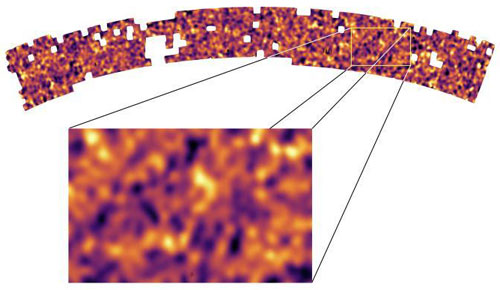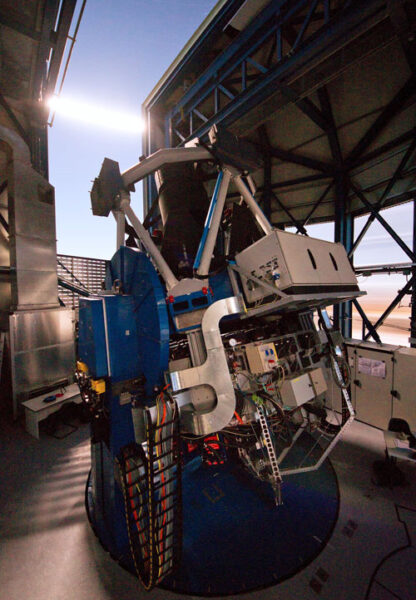The latest data release from a survey of 31 million galaxies reveals that our universe is even smoother than we thought it was.
The universe is smoother than expected.
The latest data release from the Kilo-Degree Survey (KIDS) confirms earlier indications that the current distribution of gravitating matter is less clumpy than predicted by the standard model scientists use for cosmology.
Using the 256-megapixel OmegaCAM on the 2.6-meter Very Large Telescope’s Survey Telescope at Cerro Paranal in Chile, the European KIDS collaboration has studied 31 million remote galaxies in two large swaths of sky totaling 1,006 square degrees.
Intervening matter (both visible and dark) slightly bends the light from these galaxies via weak gravitational lensing, producing tiny distortions in their shapes (see Sky & Telescope’s September 2016 issue). Precise analysis of this cosmic shear reveals how the matter is distributed.

B.Giblin / K.Kuijken / KIDS team
The European Planck mission mapped the Big Bang’s afterglow, known as the cosmic microwave background, and scientists have modeled the minute fluctuations in the glow’s temperature using the standard cosmology, which includes dark energy and dark matter. This model, sometimes referred to as ΛCDM, predicts that galaxies and galaxy clusters should group together a certain amount in the present-day universe. However, the KIDS map yields a measurement of this clustering, known as S8, that is 8.3% smaller than expected. The results have been submitted for publication in Astronomy & Astrophysics as several separate studies, and are currently available in preprint form.
According to KIDS project lead Koen Kuijken (Leiden Observatory, The Netherlands), the team has taken care to minimize all potential systematic errors, both in the observations and in their analysis. “Compared to our 2016 data release [based on half as much data], the difference with the ΛCDM predictions is a bit smaller, but the error bars are much tighter,” he says.
The statistical significance of the result is 3 sigma, which means there’s only a 1 in a 1,000 chance that the findings could be caused by scientists having looked at a particularly unusual part of the universe, according to team member Benjamin Joachimi (University College London) in a press statement.
The ΛCDM model also predicts a value for the Hubble constant — a measure of the current expansion rate of the universe — that is not borne out by measurements of objects in relatively nearby galaxies (see the June 2019 issue of Sky & Telescope). New results continue to extend that cosmic controversy. The two issues may be related, says Kuijken, but it’s too early to say if they really point to a fundamental problem with the standard cosmological model. “Maybe it’s just a matter of relatively small modifications.”

ESO / INAF-VST / OmegaCAM / G. Lombardi (glphoto.it)
But according to theorist Avi Loeb (Harvard University), progress in physics traditionally follows anomalies. “If the anomaly in S8 and the Hubble constant stands the test of time, then both may imply new physics,” he explains. “It would be attractive to kill two birds with one stone. So far, however, I have not seen an elegant theoretical idea that can account for the Hubble tension, let alone the anomaly in S8.”
Analysis of the full 1,350-square-degree dataset of the KIDS survey is now underway; the fifth and final data release is expected next year. Another cosmic-shear project, the Dark Energy Survey has just published results from their first survey year, yielding a clustering parameter 5.5% smaller than the ΛCDM value. A third project with the Japanese Hyper Suprime-Cam Survey is also expected to publish results within the next few months
Starting three or so years from now, the European Space Agency’s Euclid mission and the Vera C. Rubin Observatory will greatly improve on current surveys, both in sensitivity and in sky coverage. Eventually, it will become clear whether or not we’ll have to discard our cherished theoretical model of the universe.
“The history of physics teaches us modesty,” says Loeb. “Sometimes nature is much more imaginative than we are.”
 11
11









Comments
Sciencesprrings
July 31, 2020 at 2:04 pm
Link to science paper is unclear. Please revise and advise me. You have my email address.
You must be logged in to post a comment.
Monica Young
August 3, 2020 at 10:24 am
Dear Sciencesprings - there were actually several papers, the link is to all of them.
You must be logged in to post a comment.
Peter Wilson
July 31, 2020 at 8:56 pm
Again, what is needed is not new physics, but inclusion of old physics.
From one of the abstracts (the link in the article links to about 100): “The scale-independence and redshift-dependence of these measurements are consistent with the theoretical expectation of General Relativity in a Universe with matter density Ωm=0.27±0.04.”
Sounds impressive, but it means nothing. It is in reference to the Friedmann equations, not our universe. In these equations, the basis of the lambda-CDM model, there are no stars nor galaxies. Only a uniformly expanding, ideal gas. All the complicating factors associated with star-formation—eta, R_i, LD, etc—have been omitted, for mathematical expediency. When are we going to get a realistic model?
Dark Energy Dialogue: https://youtu.be/4goInwbOix4
You must be logged in to post a comment.
Andrew James
August 7, 2020 at 3:31 am
Sounds impressive, but it means nothing. Agreed.
You must be logged in to post a comment.
Scope58
August 1, 2020 at 5:51 am
A significance of 3 sigma should mean a 1 in 100 chance, not 1 in 1000. Shouldn't it?
You must be logged in to post a comment.
JimL77
August 1, 2020 at 6:46 pm
For 3 standard deviations units each side of the mean, there is a probability of 2.70 out of 1,000 (i.e., 1 in 370) that an unusual part of the universe was observed.
You must be logged in to post a comment.
Anthony Barreiro
August 3, 2020 at 2:24 pm
I think a one-tailed significance test is warranted in this case. We know for sure that the universe is not so lumpy that the error could possibly be in the other direction.
You must be logged in to post a comment.
Anthony Barreiro
August 2, 2020 at 6:55 pm
3 sigma is equivalent to 99.87 percent probability. In other words, assuming a normal distribution, a 3-sigma result would occur by chance 13 times out of 10000. Rounding off to one significant digit, that's one out of a thousand.
https://www.zmescience.com/science/what-5-sigma-means-0423423/
You must be logged in to post a comment.
stargate
August 2, 2020 at 1:38 pm
The lambdaCDM model is a good example of the theory leading the science. Its developers hailed it as a theory that could explain most cosmological observations with only five adjustable parameters. But as is often forgotten, two of these parameters were the "invention" of dark matter and dark energy. For the past 40 years billions of dollars have been spent trying to identify these new forms of matter and energy. But no direct evidence has been found while much of the indirect observational evidence can either be explained by other processes or remain unexplained.
Dark matter and dark energy are today accepted as physical facts. But in fact, they are artifacts of an obsolete model that needs to assigned to the circular file of failed scientific "theories".
You must be logged in to post a comment.
Peter Wilson
August 3, 2020 at 12:42 pm
I am not dismissing either. I have offered an equation for dark energy:
Lambda = eta/(R_i)^2.
See Dark Energy Dialogue, in above post, for a complete description of the factors, eta and R_i. The authorities dismiss the equation as wrong, but do not have a correct one to offer in its place. They simply ignore the principle of action and reaction, which eta and R_i quantify. If my equation is wrong, then show me the correct one. If my equation is correct, then say something. Thanks.
You must be logged in to post a comment.
Andrew James
August 7, 2020 at 2:26 am
What authoriities say this?
You must be logged in to post a comment.
You must be logged in to post a comment.